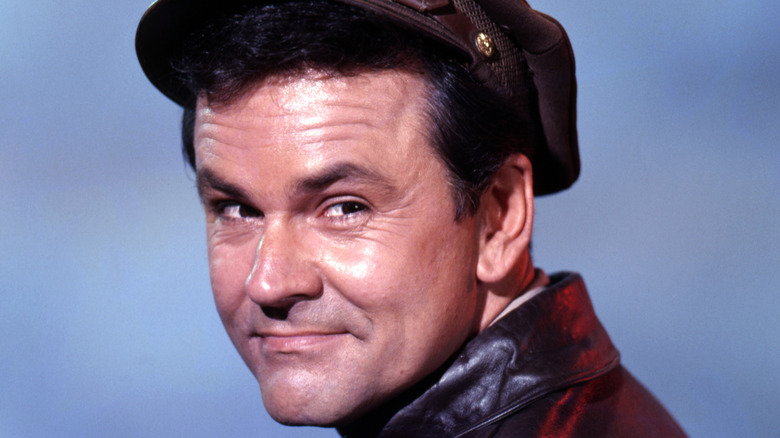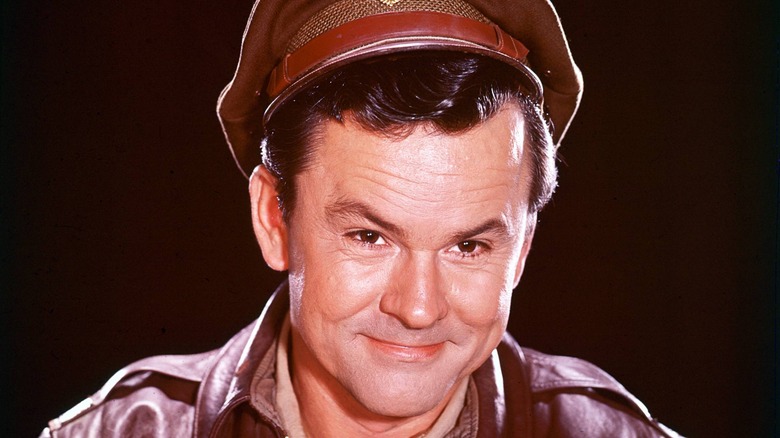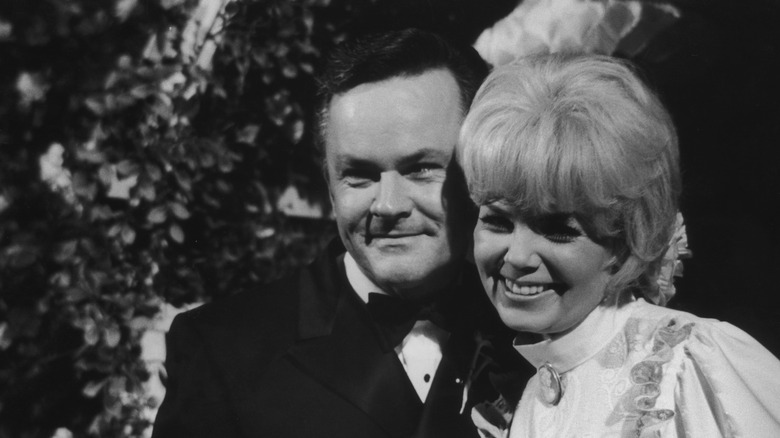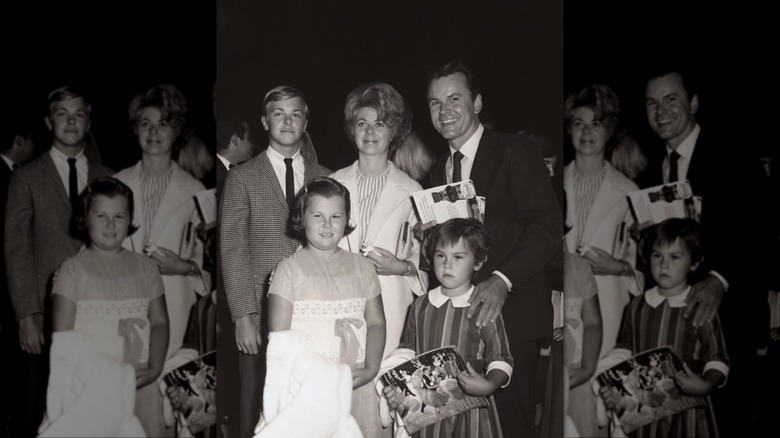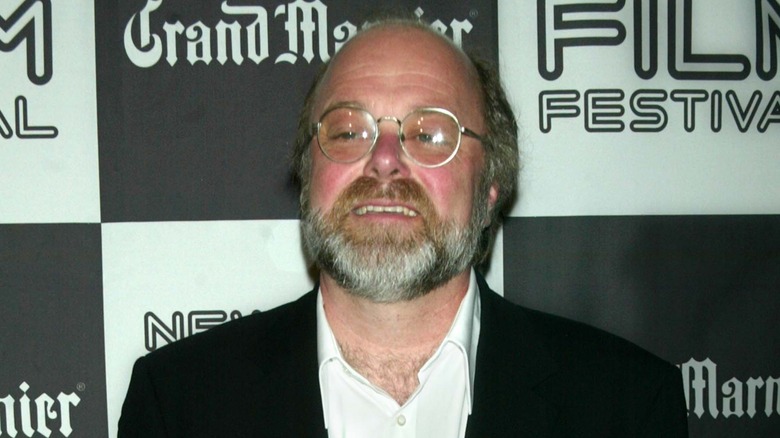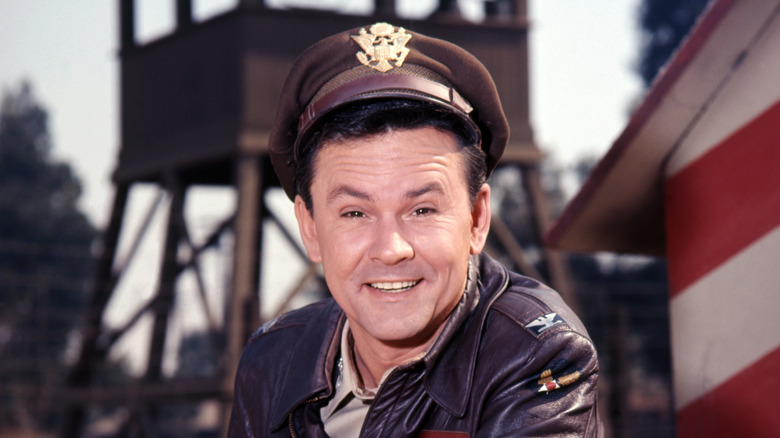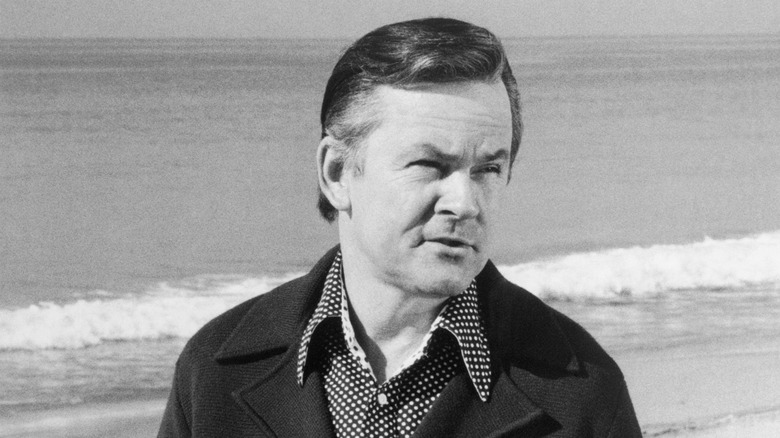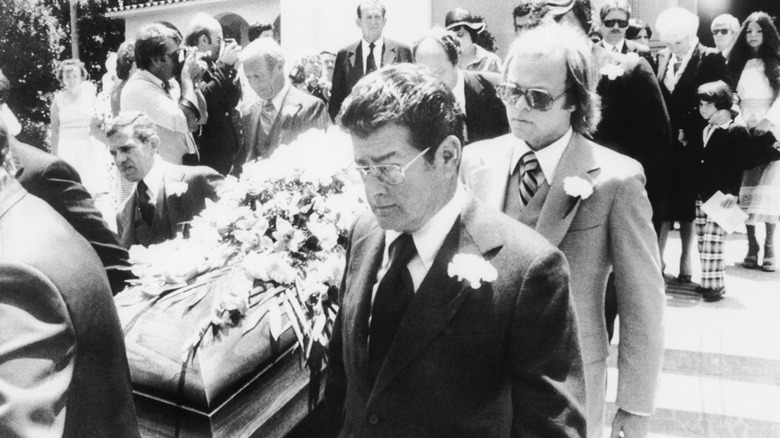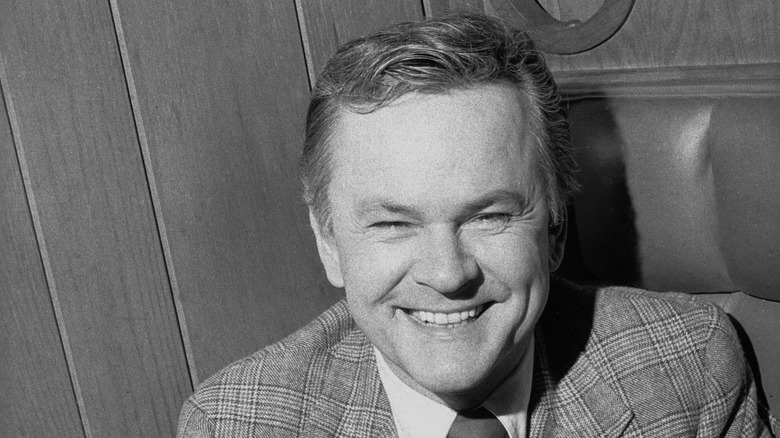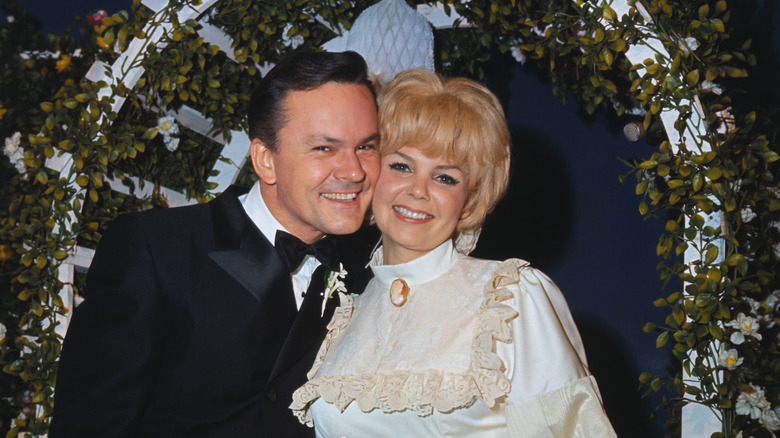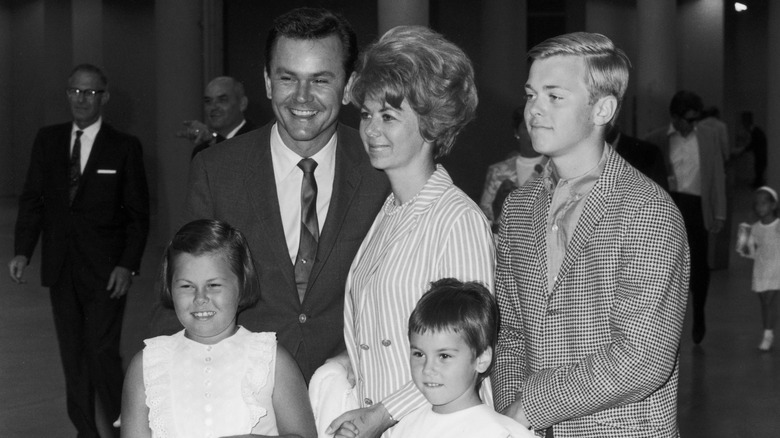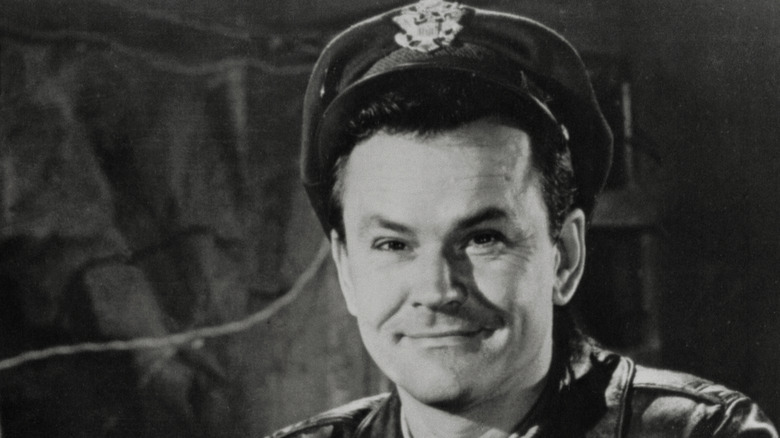The Dark Side Of Bob Crane
The much-loved CBS sitcom "Hogan's Heroes," which ran from 1965 to 1971, was initially highly controversial. Set in a World War II Nazi prisoner-of-war camp, the show followed the adventures of a group of prisoners as they worked to get one over on the camp leadership, particularly the ineffectual Colonel Klink. That a show was willing to portray Nazis in a comedic light was deeply shocking to American audiences for whom the war itself was still a living memory.
However, "Hogan's Heroes" also gave viewers a defiant cast to root for. At the heart of the show's success was the character of Hogan himself, played with exceptional charm by Bob Crane, who became a huge star. Crane had originally made his name in radio as a disc jockey and drummer before landing the leading role in "Hogan's Heroes," which would make him a household name. Even after "Hogan's Heroes" ended, the show remained familiar to audiences through syndication and re-runs. But some sitcom stars of the era harbored dark secrets, and Crane was no exception. Little did viewers know that the actor was notorious in the entertainment industry for a number of reasons. Crane was able to leverage his fame for his own ends — especially when it came to attracting sexual partners. Though his career faded following "Hogan's Heroes," the actor lived the life of a hedonist until, at the age of 49, he joined the ranks of actors who were tragically murdered. After his death, many sordid details of his life came to light. Here is the dark side of his story.
Bob Crane's sex addiction
From his radio career to his numerous television appearances — which included guest spots on other sitcoms as well as "Hogan's Heroes" — as well as on the stage, Bob Crane was well known for his considerable charm. What his audiences didn't know, however, was that Crane's charm won over more than his viewers.
Biographers such as "The Murder of Bob Crane" author Robert Graysmith have described the actor as having an all-consuming obsession with sex. This obsession manifested in an addiction to pornography, which Crane took with him everywhere, even his dressing room on the set of "Hogan's Heroes." Crane — who was married twice — also found that as a famous face he was able to indulge his obsession with sex by attracting fans with his fame. Though sex addiction wasn't a commonly known phenomenon in the mid-20th century, outlets today agree that the term would likely apply to Crane. While being a celebrity certainly helped the actor feed his desires, the behavior would prove to have disastrous consequences for his career and his personal life, and, according to Graysmith and others, potentially played a part in his death.
His habit affected his career
Several of those who were close to Bob Crane have reported that he was open about having adult material in his possession, and was quick to show pornographic photographs to friends, colleagues, and even acquaintances he had only recently met. It was during the filming of "Hogan's Heroes," a show with a punishing recording schedule, that Robert Graysmith cites as a period when Crane's addiction became all-consuming.
Crane also used filming as a means of meeting sexual partners. Among the affairs he conducted at the time included the actress Cynthia Lynn, who played Hilda on "Hogan's Heroes." Once their affair came to light, Lynn's husband forced her to quit the show, and she was replaced by a woman named Patricia Olson, aka Sigrid Valdis (pictured). Crane would begin an affair with Olson, too, who would go on to become his second wife.
Crane's sex obsession was an open secret in the entertainment industry. As such, production companies such as Walt Disney Pictures, which in 1972 was working on a family-friendly movie called "Superdad," with Crane in the lead role, grew concerned that rumors about the actor's private life would impact their movie at the box office. Crane's son Robert suggested in his book "Crane: Sex, Celebrity, and My Father's Unsolved Murder" that the actor's openness about pornography on set prevented his career as a family-friendly film star from taking off after "Hogan's Heroes," with "Superdad" bombing at the box office.
Troubled marriages
Bob Crane married his first wife, Anne, in 1949, when he was in his early twenties. Though per "The Murder of Bob Crane," Crane later claimed to a friend that he had lived a monogamous life with Anne throughout their marriage, Robert Graysmith notes that the actor's relationship with his first wife began to fall apart around the time that he became a household name as the star of "Hogan's Heroes," at precisely the time that he began to become addicted to pornography.
Crane was reportedly a responsible family man during his radio days, but by the time he was a TV regular he was engaged in numerous affairs that drove him further away from his wife and three children (pictured). He began his relationship with Patricia Olson while still married to Anne, claiming that his co-star was "the most gorgeous woman I've ever laid my eyes on. She's like my other half. I never felt complete until now." However, though he and Olson would marry and have children of their own, Crane's extra-marital affairs would become more frequent, leading to his separation from his second wife shortly before his death. By then, his and Olson's relationship had turned vicious, with Olson claiming that the famous actor had shown their son, Scott, pornography when he was just 6 years old.
He took his son to an X-rated premiere
As Patricia Olson's accusation suggests, Bob Crane may have been found wanting when it came to knowing where to draw the line between family and sex, and when to censor his own sex life around family members and colleagues. His son Robert (pictured) recalls in "Crane: Sex, Celebrity, and My Father's Unsolved Murder" that when he was a teenager he even watched pornography with his father at public events.
In 1972, Crane took his son to the premiere of the X-rated movie "Deep Throat," a feature-length film with a bizarre premise that became a notorious cult hit. Robert recalls that his father had no qualms about watching the movie with him. At the premiere, Robert found himself surrounded by porn stars and other members of the adult film industry at the rather dilapidated Pussycat Theatre in Hollywood. Robert claims that despite the adolescent thrill he got from being in an adult film theater, he quickly grew jaded by the experience. His father, on the other hand, was enthralled by the movie, and later recut the film himself, along with clips of mainstream TV shows, the juxtaposition of which he would play for his friends as a joke. Despite Olson's accusations against him and Robert's bizarre recollections regarding visiting the premiere with his father, Crane's children from his first marriage have generally sought to praise the actor as a good father and lots of fun.
Bob Crane videoed his partners
That a male TV star of the 1960s and 1970s had countless affairs with starstruck women he encountered isn't especially notable. But Bob Crane's sexual exploits are more unusual than most playboys of the day because of his predilection for chronicling his conquests on camera. According to Robert Graysmith's "The Murder of Bob Crane," the actor would take photos of the women he slept with, both clothed and unclothed, and would also make graphic homemade films of the sex acts they performed together. "I'm a videotape nut," he told theatrical stage manager Chris Roberts.
It was a habit that he continued throughout his life, and over the course of his activities he amassed a huge stock of material in the form of videotapes and Polaroids of women with whom he had liaisons. Crane was more than happy to share this homemade pornography with friends and acquaintances.
Crane's son Robert has claimed in his book that all the video recordings and photographs the actor collected to document his promiscuous sex life were taken with their subjects' explicit consent. However, not everyone agrees, with Graysmith countering that the footage itself seemed to suggest that not all of the women involved were aware that they were being filmed for Crane's gratification.
Isolated and lonely
Robert Crane has remained adamant that his father's promiscuous lifestyle was dependent on the actor's charm. "There were no drugs, no coercion, none of that," Robert told Entertainment Weekly. "Women just liked him, or found him handsome, or whatever it was. They would hook up." Meanwhile, the scriptwriter Tony Castro has told Robert Graysmith that he has it on good authority that Crane was involved in the Los Angeles swing scene, and was known to have ads placed in magazines to find kink-focused sexual partners when he traveled. Castro claims that Crane would finance the building of sex dungeons in multiple cities, and he would also catalog his X-rated photographs by location.
But despite his countless sexual liaisons and apparent network of like-minded partners, in later life, Crane grew to be an isolated figure. Stage manager Chris Roberts informed Graysmith that though the actor would typically have many acquaintances around him and would go out on the prowl most nights looking for women to hook up with, he believed the actor was lonely at heart.
His murder may have been related to his sexual escapades
On June 29, 1978, the body of Bob Crane was discovered in a Scottsdale, Arizona, apartment, where he had been living while performing in the play "Beginner's Luck" at the Windmill Dinner Theatre, dinner theater being his main source of income in the last years of his life. The body was discovered by a co-star, Victoria Berry, who grew concerned when Crane failed to appear for lunch and went to check on him in his apartment and found his front door open.
Berry found Crane lying on his bed, his head in a pool of blood. He was unrecognizable, with blood also splattered on the bedroom walls. He had been bludgeoned to death and had an electrical cord wrapped tight around his throat.
Though Crane was fully clothed, the scene showed signs of his sexual activities. The scene of Crane's murder contained much of his homemade pornographic material, as well as Crane's notorious black bag, which those close to him knew contained various X-rated materials and equipment for filming. This time, the bag had been opened, and something taken something from it. Investigators later speculated that the murder weapon that had fatally struck Crane on the cranium and temple may have been a tripod for a video camera. Robert Crane claims in "Crane" that the actor's second wife, Patricia Olson, told him: "Your father's lifestyle caught up with him."
Crane's partner-in-crime may have turned on him
News of the murder of Bob Crane unleashed a flurry of speculation as to the killer's motive. The closest scrutiny fell upon John Henry Carpenter, a video camera salesman who had been introduced to Crane by the latter's "Hogan's Heroes" co-star, Richard Dawson (whose own surprising history is detailed in our feature The Untold Truth of Richard Dawson). Crane was first put in touch with Carpenter to buy camera equipment, but the two soon became friends who would cruise bars in towns across America — Carpenter would reportedly arrange his work to coincide with Crane's theater tours — and pick up women together, or else attend planned orgies. They would also film their trysts with the women they met.
Carpenter became an early suspect in the Crane murder investigation, with witnesses claiming that the two friends had a falling out shortly before Crane was found dead. As Robert Crane told Entertainment Weekly, investigators believed that Crane had decided to end his friendship with Carpenter, who may have grown enraged by the prospect of the loss of his partner in crime; after all, it was Crane's fame that helped them hook up with women. Though Carpenter was arrested and put on trial for Crane's murder, he was ultimately acquitted. However, in 1992 he pleaded no contest to unrelated charges of sexual battery and sexual misconduct with a minor, leading to three years probation.
Bob Crane's lifestyle may have made him enemies
Though John Henry Carpenter was never convicted of Bob Crane's murder, many of those close to the case have continued to suggest that he was involved. He died in 1998, at the age of 70, having claimed that his life had been destroyed by the allegations.
While suspicion has remained with Carpenter, other theories have emerged regarding Crane's brutal murder that are also connected to Crane's sex life. Some believe that Crane may have met his end at the hands of a jealous husband or partner of one of the women he filmed — indeed, some pornographic material is believed to have been taken from the scene, which some have interpreted as meaning that a jealous partner had taken away evidence of an affair. Elsewhere, some have highlighted that Crane was estranged from his wife, Patricia Olson (pictured), at the time of his death, and that they were going through a divorce. A friend told Robert Graysmith that the couple's arguments had grown violent prior to their separation; the fact that there was no forced entry suggests Crane knew his killer.
Despite such theories, the Bob Crane murder case remains unsolved, and with Carpenter's death it seems unlikely that the truth of the matter will ever come to light. But like so many unsolved celebrity deaths, the murder of Bob Crane continues to compel audiences, and has been investigated by true crime journalists and podcasters. Crane's bizarre story even resulted in a feature film, "Auto Focus," which was released in 2002.
Crane's broken marriages set his family at war
Though no evidence exists that Patricia Olson was in any way involved in Bob Crane's murder, it is undeniable that their relationship had truly become vicious before his death. As well as physical altercations and Olson's allegations concerning Crane's exposing their son to pornography while he was still a minor, the marriage had grown tense due to disputes between Olson and other women in Crane's family, including his mother and his daughters from his first marriage, according to Robert Graysmith.
Olson's claims that Crane was a bad father and user of pornography made their way into the press, which caused a final rift between Olson and other members of Crane's family, such as his son Robert, who had originally been accepting of his stepmother. Meanwhile, Robert's involvement in the movie "Auto Focus" enraged his half-brother, Scott, who described the film as a "distortion" of the truth and even went as far as to accuse Robert of being involved in his father's death, though he has never been made a suspect by police and claims to have never been to Scottsdale until after Crane was murdered (per "Crane"). In response, Robert doubled down in accusing Olson.
After Crane's murder, the actor was buried at Oakwood Memorial Park Cemetery in Chatsworth, California, beside his parents. However, in 2002 it was reported that Olson had relocated Crane's remains to Westwood Cemetery, where many famous actors have been buried, and secured a plot for herself alongside him — without informing the rest of his family.
Bob Crane's relatives published his sex tapes
But there was one final twist in the story of Bob Crane. Though a small amount of his vast homemade pornography collection reportedly went missing from the murder scene, much of it remained, and wound up in the hands of his family. Years later at the dawn of the internet, Patricia Olson and her son Scott set up a memorial website for the deceased "Hogan's Heroes" star – without the involvement of Crane's first family. But rather than a simple memorial, the website also gave a contentious account of the final days of Crane's life and the aftermath of his death, in which Olson claimed that she and Crane had reconciled and that she and Crane's son Robert had grieved together over the actor's murder. The website also offered a subscription service publishing Crane's vast collection of homemade pornography, much to the horror of other members of the Crane family.
In "Crane: Sex, Celebrity, and My Father's Unsolved Murder," Robert Crane claims that Olson's description of the events surrounding Crane's murder was fabricated. Robert was absent from Crane's will, which he believes was orchestrated by Olson and Crane's financial manager, who Robert says embezzled thousands from the actor. He describes his stepmother as a "pimp" for her monetization of his father's sex tapes and photographs, the circulation of which caused a storm in the media. Scott eventually shut down the website, though by then much of Crane's collection was already immortalized on the web. He has since destroyed the originals, according to Entertainment Weekly.
